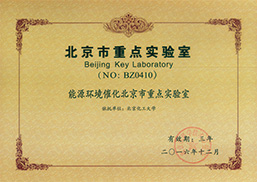重点实验室主任张润铎教授出席“The 8th international conference on biorefinery and biomanufacturing”并作主旨报告
会议名称:The 8th international conference on biorefinery and biomanufacturing
会议时间:2023.7.21-2023.7.27
报告题目:Catalytic pyrolysis of bio-plastics into carbon nanotubes and hydrogen and downstream methanol to olefin

Catalytic pyrolysis of bio-plastics into carbon nanotubes and hydrogen and downstream methanol to olefin
Runduo Zhang*, Ying Wei, Jingbo Jia
State Key Laboratory of Chemical Resource Engineering, Beijing Key Laboratory of Energy Environmental Catalysis, Beijing University of Chemical Technology, Beijing, 100029, PR China
Bio-based plastics can partially alleviate the intensive usage of petroleum resources. Unfortunately, the disposal of these bio-plastics might bring new risk and challenge. The Waste-to-Energy incineration is one of the options, but the release of greenhouse gases and pollutants will do harm to the environment and human health. As a result, applying thermocatalytic approaches to upgrade plastics into valuable chain products such as carbon nanotubes (CNTs), hydrogen, and other light carbon-containing organic matters to achieve better circular economy of plastics is more desirable. Meanwhile, the downstream product methanol can be further resourcefully utilized as high value-added light olefins.
Pyrolysis and in-line catalytic technology were employed to converting polyethylene plastics to CNTs and hydrogen.To improve the catalytic performance of Ni–Mg system, high-valency and refractory tungsten as a promoter was introduced. The sample with W/Ni atomic ratio of 1/7 exhibited the mixed phase of MgNiO2 and MgWO4 and showed the highest yields of CNTs and hydrogen.The highest yields of CNTs with average diameter of 11 ± 2 nm (0.21 g/g) and hydrogen (26 mmol/g) when the reaction temperature was 800 °C.The modulating strategy enabled the partial electron transfer from Ni to W, creating the abundant quantities of active Ni nanoparticles with high stability and catalytic activity towards the hydrocarbon decomposition. Simultaneously, the interaction between Ni and W2C regulated the carbon concentration surrounding Ni to ensure the growth of CNTs. These findings would be conducive to the reasonable design of highly efficient catalysts maximizing the yields of CNTs and hydrogen produced from plastics.
The downstream methanol-to-olefin (MTO) process is important for sustainable production of light olefin from biomass via fermentation or chemical conversion in the future. Small-pore silicoaluminophosphate (SAPO) molecular sieves are effective catalysts for MTO reaction due to their unique shape-selectivity and moderate acidity. We reported on the facile synthesis of SAPO-LTA structure, an interesting candidate catalyst, through ionothermal approach in imidazolium-based ionic liquids. By using several characterization techniques, including XRD, SEM, NMR, BET, ICP, NH3-TPD, physicochemical properties of SAPO-LTA prepared with different amount of silicon added in the initial reactants has been studied. SAPO-LTA catalyst showed an obviously improved catalytic activity with the increasing of silicon content, high light olefins selectivity (~ 75%) and better C4= selectivity than industrialized SAPO-34 catalyst.
Key words: Bio-plastics; Methanol-to-olefin; Catalytic pyrolysis
Email: zhangrd@mail.buct.edu.cn



